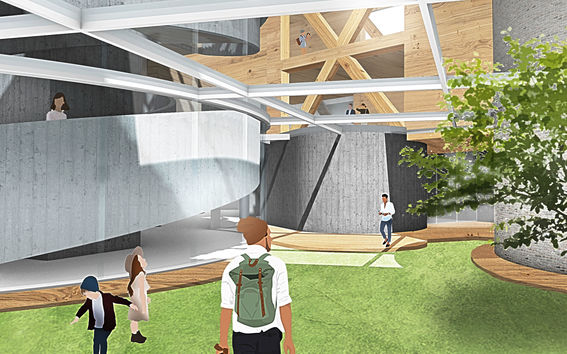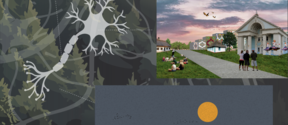Consequential Pragmatism
Such approaches have emerged in architectural theory and research during past twenty years which could be called critical pragmatism. I mean methods which combine critical thinking with practicality in the design process. The traditional critical approach in architecture typically means identifying challenges in the social, cultural, economic, and environmental practices of architecture, whileas architectural pragmatism has not that much concentrated on identifying challenges, but on the results of architectural projects. The dogs bark, but the caravan goes on. But now the dogs work with the camels. Critical pragratism attempts co combine both of these perspectives - to fuse barking and going on.

In critical pragmatist thinking, a design process should include a pragmatic evaluation of how successful the end results are in challenging normative solutions. Without this check of consequences, critical pragmatism would not be pragmatism. When critical pragmatism combines elements of the two perspectives (dogs and camels), it integrates critical inquiry with practical problem-solving, aiming to have an effect in two directions: 1) dogs address real-world challenges while 2) camels question assumptions, ideologies, and social norms. Due to its critical side, critical pragmatism often involves interdisciplinary collaboration opening viewpoints of analysis and openness to diverse perspectives. Architects practicing critical pragmatism may draw from fields such as sociology, anthropology, psychology, or environmental science to inform their work. They might want to create design that not only serves its immediate purpose, but also contributes positively to good life, culture and communities over the long term.
There have been different sorts of critical pragmatist approaches with varying emphasis, or sub-genres over the past years. These include what could be called (labels mine) consequential pragmatism (by such authors as Pauline Lefebvre, Arie Graafland, Joan Ockman and Andre Liem), experiential criticism (David Macarthur), critical post-critical (Wes Jones, George Baird), new purism (Jianfei Zhu, Tahl Kaminer), disciplinary activity (Leandro Medrano) and new materialism (Matthew Mullins, Mitchum Huehls & Rachel Greenwald Smith and Manuel DeLanda). All of these sub-genres have anyway that in common that they challenge conventional socio-spatial norms and established conventions in pursuit of better solutions. The challenged conventions they have targeted have been, e.g., the assumed superficiality of aesthetics (Pauline Lefebvre), existing power structures, economic and purely functional approach ruling over environmental sustainability (Arie Graafland), aesthetics without life-defining capacity (Joan Ockman), sustainable products without visual appeal (André Liem and Leandro Medrano), manipulation and ideological smoothing (Michael Hayes), fluffy certainties, ”greenwashing”, simplification and traditional aesthetic norms in sustainable architecture (David Macarthur), conservative distinctions between public and private spaces (Gabriel Fuentes),stagnated notions on what design practice should be (Wes Jones), architecture without resistance and opposition (George Baird), the ability of modernist architecture to advocate social change (Tahl Kaminer), cultural hegemony without regional interpretation (Jianfei Zhu), neoliberalist visual appeal (Leandro Medrano), or otherwise architecture that distracts from pressing social and environmental challenges. This article concentrates on how consequential pragmatism emerged from projective practices.
Critical Pragmatism since 2002
It was namely Robert Somol's and Sarah Whiting's (2002) article on projective practices which started reproval over critical architecture – criticism on architectural analysis that doesn't contribute to creative practice at all. During the past twenty years, this criticism of criticism has also sometimes shown its own shallowness in the opportunistic production of whatsoever real estate development "projective" architectural companies are open to support. Examples of this exploitation have been Dubai's rapid and rootless urban development gladly participated by the elite of global architects. On past 20 years, a cornucopia of architectural mega-projects has appeared in emerging markets, e.g. in Dubai, China and Qatar, as well as "starchitect"-driven projects, which don't necessarily respect local conditions or address any critical questions about the development of culture and life, but merely just obey an architect's brand. Perhaps because of this nihilistic capacity of pragmatism, the political agendas that were embedded in the Critical School re-emerged in the recent interest of the critical pragmatist architects to tackle social disparities and environmental problems. One must though say that it remains unclear whether the anti-critical discourse was not simplifying and biased in its analysis of critical architecture and whether projective practices themselves lacked critical intentions. It is also obscure whether the present tendencies, which combine critical thought to pragmatism are a consequence of an evolution from critical to projective or from projective to critical. These labels and their associated practitioners seem to misread each other's fundaments, exaggerate the choosing between analysis and making, and it is questionable if the development of architecture follows a linear, dialectical or confusing path. The early pragmatist William James himself criticised Hegel's dialectics for having little practical applicability (1987: 568), but in Slavoj Žižek's critical pragmatist treatise based on Hegelian dialectics, one can see developed very pragmatic viewpoints, e.g. about exclusion and inclusion, criticality as the presupposition for entering uncharted territory, in a very James way not knowing the results beforehand, inspiring change, where it is not the presupposed ideological edifices that produce the end result, but the liberality of the process itself.
Various critical pragmatist tendencies have followed the following steps at large:
1) In a critical manner, identify challenges in the social, cultural, economic, and environmental and sustainable contexts in which architecture exists. This contextual basis might address such factors as sustainability, values or aesthetics (Yaneva 2009, Guy 2010). Critical practice encourages to question conventional norms and challenge established conventions in pursuit to better solutions (Mazé & Redström 2007).
2) In an un-critical manner, produce experimental design and interventions with possible answers to the challenges (Rylander 2012, Mazé & Redström 2007).
3) The process ends with an evaluation of how successful – instrumental – the specific implementations have became in a defined context in the manner of projective practices (Somol & Whiting 2002, Baird 2004).
Consequential pragmatism
Pauline Lefebvre (2014, 2017, 2018a, 2018b) writes that new type of pragmatist action in architecture could offer a different form of political engagement and moral responsibility, anchored to practice. She has observed the emergence of a political posture which is embedded within practice, where this stance is characterised by an increased commitment to the specific tools and materials of architecture, investigating its most technical aspects. She writes that pragmatist political performs architecture’s impacts in the social, economic, environmental and aesthetic. Lefebvre (2017) states that pragmatism does not suggest the abolishment of theory or does it imply a focus on architecture’s practical effects in a narrow sense. Se writes that its forms and its materiality situates architecture in its context, demands to which it has to answer, and new elements it brings to existence. She asks what is the world that our design choices bring into being, and how can it be better than the one we have now. This emphasises the restrictions and possibilities of a project: its given context, and the brief, as basis for work and its evaluation. Lefebvre explores how aesthetics is not just about the appreciation of beauty or art but also about the way we engage with our environment, perceive spaces, and experience everyday life. Lefebvre investigates how our aesthetic experiences shape our perception of the environment. She is interested in how sensory engagement with the natural world affects our cognitive and emotional responses, influencing our broader environmental awareness and attitudes. Lefebvre also touches on the ethical dimensions of environmental aesthetics, considering how our aesthetic appreciation of the environment can foster a sense of responsibility towards it. She suggests that engaging with the environment aesthetically can lead to a more profound respect and care for the natural world. But is this enough? It is quite obvious that we appreciate environment if it has aesthetic qualities that please us, but not everything is pleasing. There can also be inherent aesthetic problems in architecture, including such issues as lack of cohesion, poor proportions and scale, inappropriate contextual matches – misplaced expression, style or effects regarding, e.g. monotony, diversity, decorativeness, or short-lived creations. Many architects have processed aesthetic problems. One of the most analytical approaches in this respect, Christopher Alexander's A Pattern Language (1977), focussed on the principles that make buildings and cities aesthetically cohesive and human centered. Alexander critiques modern architecture for often lacking these qualities, leading to milieus that feel disjointed or uncomfortable. His concept of "patterns" in architecture emphasises the importance of proportions, scale, and contextual appropriateness. More recently, and less analytically and more poetically, Rem Koolhaas' S,M,L,XL critiqued the monotonous or overly decorative aspects of some modern developments, advocating other aesthetic criteria such as "congestion" and "bigness".
The ability aesthetics to distract us from other important issues, which Lefebvre mentions, is an old topic in the theory of aesthetics: Excessive focus on aesthetics can distract people from other pressing issues such as social justice, environmental sustainability, or human rights, even though beauty and ethics are not mutually exclusive. For example, the classic of Critical Theory, Theodor Adorno argued that the culture industry (mass media and entertainment) uses aesthetics to pacify and manipulate the masses, creating a form of distraction that diverts attention from social injustices and political oppression. Adorno criticised how aestheticised culture can create a sense of false consciousness, leading people to focus on superficial beauty rather than meaningful change. The American art theorist and critic Susan Sontag's Against Interpretation and On Photography critique the overemphasis on aesthetics, particularly in art and media, arguing that this focus can lead to a shallow engagement with content and distract from deeper political and social issues.
Although Pauline Lefebvre might not have explicitly listed specific examples in her works, projects that align with her ideas that could be labeled consequential pragmatism could be for example Alejandro Aravena's social housing projects such as Quinta Monroy Housing in Iquique, Chile, and Lacaton & Vassal's transformative renovations such as Tour Bois-le-Prêtre in Paris. Aravena’s work with social housing focuses on providing affordable and expandable housing solutions that empower residents to participate in the design and construction process. The "half-houses" concept, where the government builds half of a house, leaving space for residents to complete the other half according to their needs and resources, exemplifies consequential pragmatism. It addresses urgent social needs while allowing for future growth and adaptation. Lacaton & Vassal's renovation added generous spaces like balconies and winter gardens, enhancing the quality of life for inhabitants without displacing them. However, it remains unclear how much the social beneficiality of these projects is the consequence of a cultivated client or the architect's determination.
Arie Graafland (2015) asks for a better understanding of architecture's social issue – its practices, context and use, and asks to whom the aesthetics of architecture are made for. This is the challenge with subjectivity and cultural appropriation in art and architecture. Architecture creates emotions, feelings and atmospheres, whose aesthetic judgments can lead to conflicts or misunderstandings when individuals or groups have different tastes or preferences. Borrowing or adopting architectural elements from another culture without proper understanding or respect can be offensive or disrespectful. This can perpetuate stereotypes, marginalise minority cultures, and contribute to cultural insensitivity. Edward Said's Orientalism is a classic or criticising how Western aesthetics have appropriated and misrepresented Eastern cultures. However, conscious and skillful cultural appropriation can also critically examine conventions and stereotypes. For example, Arthur C. Danto (1974, 1997, 2002) has discussed the idea that art can transcend traditional aesthetics. His work highlights how contemporary art practices often appropriate and decontextualises cultural elements, challenging traditional aesthetic boundaries and expanding the definition of what can be considered art. Also James Young (2008) has written thoroughly about the difficulties of cultural appropriation of art and architecture is here no different.
Graafland engages often with critical theory, discussing how aesthetics can serve as a tool for critique in architecture and urbanism. He examines how aesthetic choices in design can challenge or reinforce existing power structures, especially economy and rational functionalism, and how aesthetic alternatives can be used to address social and environmental issues and contribute to the identity of a city. Graafland critiques traditional models of urban development that prioritise economic growth over environmental sustainability. He questions the environmental consequences of such models and advocates for alternative approaches that are more attuned to ecological needs. In Architecture, Technology & Design (2012), Graafland’s critique of pragmatism’s obsession with instrumentality highlights the limitations of a purely functional approach to architecture and urbanism. He challenges the idea that utility should be the primary measure of value and advocates for a more holistic approach that considers the aesthetic, ethical, and cultural dimensions of design – meaningful and enriching. Although Graafland may not have explicitly endorsed specific projects in his writings, his consequential pragmatism generally includes context-sensitive design, sustainabe practices, social impact, as well as local materials and techniques.
Maybe such a project as Francis Kéré's Gando Primary School in Burkina Faso can match Graafland's criteria. The building uses local materials and construction techniques to create an environmentally responsive and culturally appropriate building. The project emphasises symmetrical monumentality, community involvement and practical solutions to local needs, aligning with the idea of consequential pragmatism.
Bibliography
Adorno, Theodor. 1991. The Culture Industry. Routledge.
Alexander, Christopher. 1977. A Pattern Language. Oxford UP 1977. https://arl.human.cornell.edu/linked%20docs/Alexander_A_Pattern_Language.pdf
Baird, George. 2004. “Criticality” and Its Discontents. Harvard Design Magazine, 2004 (21).
Danto, Arthur C. The Transfiguration of the Commonplace. The Journal of Aesthetics and Art Criticism, Vol. 33, No. 2. Winter, 1974, pp. 139-148 https://doi.org/10.2307/429082.
Danto, Arthur C. After the End of Art. Princeton University Press 1997, https://doi.org/10.2307/j.ctv1j666c
Danto, Arthur C. The Abuse of Beauty. Daedalus, Fall, 2002, Vol. 131, No. 4, https://www.jstor.org/stable/i20027799.
DeLanda, Manuel. 2018. Causality and Meaning in the New Materialism. OUP.
DeLanda, Manuel. 2018. Architectural Materialisms: Nonhuman Creativity. EUP.
Graafland, Arie. 2012. Architecture, Technology & Design. Digital Studio.
Graafland, Arie. 2015. Criticality. https://www.academia.edu/4863307/Criticality
Guy, S. 2010. Pragmatic ecologies: situating sustainable building. Architectural Science Review, 53(1), 21–28. https://doi.org/10.3763/asre.2009.0102.
Hayes, Michael K. The New Face of Architecture
Huehls, Mitchum & Greenwald, Rachel Smith. 2017. Neoliberalism and Contemporary Literary Culture. JHU.
Jones, Wes. 2010. Big Forking Dilemma: Contemporary Architecture's Autonomic Turn. Harvard Design Magazine, 2010 (32).
James, William (1987). Writings 1902-1910 (Pragmatism). The LIbrary of America.
Jianfei, Zhu. 2005. Criticality in between China and the West. The Journal of Archtecture 2005 (10).
Kaminer, Tahl. 2017. The Efficacy of Architecture. Routledge.
Koolhaas, Rem. 1997. S,M,L,XL. The Monacelli Press.
Lefebvre, Pauline. 2014. From Autonomy to Pragmatism: Objects Made Moral. Proceedings of the 2014 Autonomy Recosidered conference.
Lefebvre, Pauline. 2017. What difference could Pragmatism have made? From architectural effects to architecture’s consequences. Footprint – Analytic Philosophy and Architecture. 2017 (20).
Lefebvre, Pauline. 2018a. The Act of Building. BC Architects.
Lefebvre, Pauline. 2018b. “What the Wood wants to do”: Pragmatist Speculations on a Response-able Architectural Practice. Architectural Theory Review, 2018 (1).
Liem, Andre. 2015. Applying Design Reasoning and Semantic Debate in Meaning and Identity Creation. AHFE 2015.
Macarthur, David. 2017. Reflections on Pragmatism as a Philosophy of Architecture. 2017. Footprint – Analytic Philosophy and Architecture: Approaching Things from the Other Side. 2017(20):105-120.
Mazé, Ramia & Redström, Johan. 2007. Difficult Forms: Critical Practices of Design and Research. IASDR. https://www.diva-portal.org/smash/get/diva2:1041796/FULLTEXT01.pdf
Medrano, Leandro. 2021. On Architecture and Urban Space after the Ideological Crisis of Neoliberalism. Taylor and Francis.
Mullins, M., (2018) “From Old to New Materialism: Rethinking Freedom after Neoliberalism”, Open Library of Humanities 4(2), 18. doi: https://doi.org/10.16995/olh.350
Ockman, Joan. 2020. Consequences of Pragmatism: A Retrospect on “The Pragmatist imagination”. In Heynen et al.: The Figure of Knowledge. Leuven University Press, 2020.
Rylander, Anna. 2012. Pragmatism and Design Research – An Overview. Chalmers Designfakultet, Kunskapssammanställningar 42.
Said, Edward. 1979. Orientalism. Vintage.
Sontag, Susan. 2001, orig. 1966. Against Interpretation. Picador.
Sontag, Susan. 2001, orig. 1977. On Photography. Picador 2001.
Somol, Robert, Whiting, Sarah. 2002. Notes around the Doppler Effect and Other Moods of Modernism. In Perspecta vol 33 (22).
Yaneva, Albena. 2009. The Making of A building: A Pragmatist Approach to Architecture. Peter Lang.
Young, James. 2008. Cultural Appropriation and the Arts. Blackwell. DOI: 10.1002/9780470694190
Show other posts from this blog

Fostering Border Crossing Creativity
This text highlights essential mindsets in radical creative leadership and some core concepts for fostering border crossing creativity based on discussions, workshops, and interviews organised by the Co-How team.
Recommendations Towards Critical Trans-Disciplinarity
We would like to propose the following recommendations for the basis of strategic tools and methods for radically creative trans-disciplinarity.
The role of infrastructure in facilitating cross-disciplinarity
Hybrid concepts and metaphors across disciplines are created by working together in concrete material-spatial conditions.